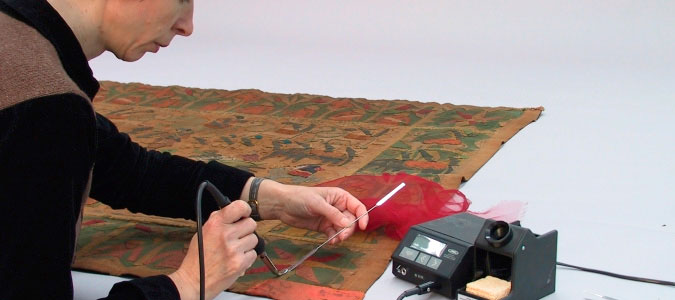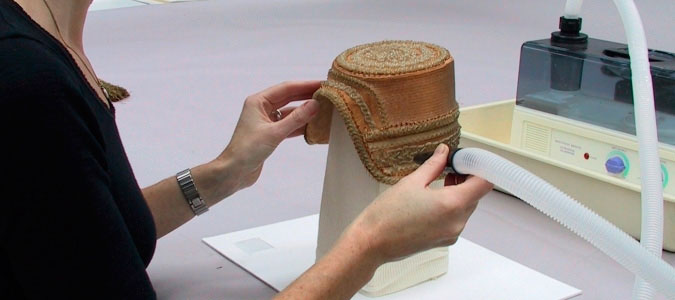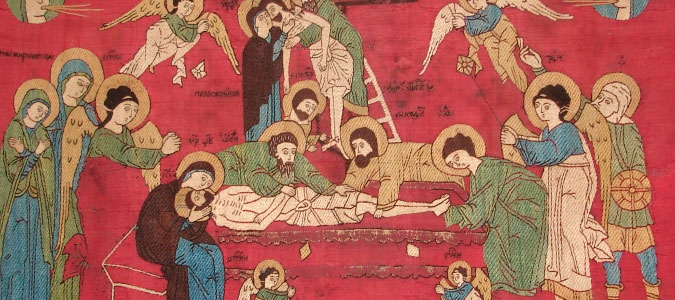
adhesive method using thermoplastic adhesive

sewing with a curved needle

treating with steam

ready for framing
Textiles are exceptional materials; with a tremendous diversity. In the first instance, textile objects comprise different, usually very fragile raw materials, like wool, silk, cotton, linen, fur and synthetic fibres. Secondly, various techniques have been employed to make the different objects, such as weaving, embroidery, knotting, felting, applique, sewing, printing, dyeing, etc. There is an enormous range of forms (varying from flat textiles consisting of one or more layers to three-dimensional textiles) and dimensions (from tapestries to carpets of dozens of square metres in size to an archaeological fragment of just a few square centimetres). Textile objects are often incorporated with other materials, such as metal in the form of silver and gold thread, paper and cardboard as filling or supporting material and wood as a supporting material. This diversity in materials, techniques and forms demands a great diversity of restoration methods and inventiveness from the textile restorer.
Textiles are very weak materials. They always perish of their own accord. But this process is accelerated through external influences, such as light and humidity, soiling, insect damage and wear and tear. The damage can be observed in the form of browning and soiling, bare and worn patches, holes, broken threads, folds and deformations, and a general weakened condition of the textile object. The objective of restoration/preservation is to delay this process.
Following cleaning, perished textile is given local or complete support with material that is appropriate for the objective of the treatment, such as the distribution of weight, fixing tears, camouflaging holes, etc. Sometimes textiles are protected from on top with nylon tulle. The supporting material is fixed either by sewing or with adhesive.
Sewing methods: During the restoration and preservation process, various sewing methods and yarns are employed.
Adhesive methods: Especially for restoration and preservation various adhesives have been developed that can be used safely. These adhesives are often thermoplastic and reversible. They can be used on a support or as adhesive membrane.
Ready for framing: Textile objects that are to be framed, such as samplers and embroidery, banners or christening gowns are fixed to acid-free cardboard sheets. These sheets are covered with materials that are most suitable for the object and are chosen by the owners themselves.
Textiles are very weak materials. They always perish of their own accord. But this process is accelerated through external influences, such as light and humidity, soiling, insect damage and wear and tear. The damage can be observed in the form of browning and soiling, bare and worn patches, holes, broken threads, folds and deformations, and a general weakened condition of the textile object. The objective of restoration/preservation is to delay this process.
Following cleaning, perished textile is given local or complete support with material that is appropriate for the objective of the treatment, such as the distribution of weight, fixing tears, camouflaging holes, etc. Sometimes textiles are protected from on top with nylon tulle. The supporting material is fixed either by sewing or with adhesive.
Sewing methods: During the restoration and preservation process, various sewing methods and yarns are employed.
Adhesive methods: Especially for restoration and preservation various adhesives have been developed that can be used safely. These adhesives are often thermoplastic and reversible. They can be used on a support or as adhesive membrane.
Ready for framing: Textile objects that are to be framed, such as samplers and embroidery, banners or christening gowns are fixed to acid-free cardboard sheets. These sheets are covered with materials that are most suitable for the object and are chosen by the owners themselves.


